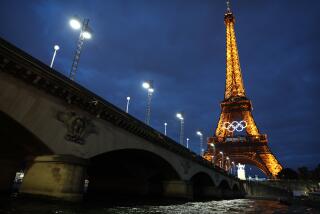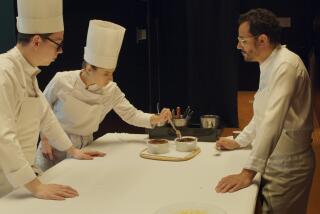Rich History, Cuisine of the Dordogne Valley
- Share via
LES EYZIES, France — While the discovery of the Lascaux Cave and this town’s Font de Gaume Grotto have established the Dordogne Valley as the birthplace of man in France, what is more important to the visitor is that this valley has remained relatively undiscovered, a green and gorgeous stretch of countryside inlnad from Bordeaux.
Known as Perigord until the French Revolution, this land afterward became the Dordogne, but the two names are used interchangeably. However, the distinctive and very rich cuisine is still known and beloved by Frenchmen as Perigourdine, a cornucopia of truffles, sauces, several commendable wines, foie gras and duck and goose.
The French have an expression, repas de battage, meaning that the cook must prepare for a ravenous group eating as if it were their last meal. One often gets that feeling here.
Bucolic is certainly the word for the Dordogne. It is rich in history, even richer in pretty little 13th-Century towns, many of which sprang up during the Hundred Years’ War. And Les Eyzies is one of half a dozen villages that makes a great base for exploring this captivating area.
Here to there: Fly Air France nonstop to Paris, or Air Canada, American, Pan Am, TWA, Delta and Continental with changes. Air Inter will get you down to Bordeaux, or get a France Vacances rail pass for visiting most towns in the country. A train also will take you from Bordeaux to Les Eyzies.
How long/how much? A day will do it for the town, but if you’re using it as a base, plan on at least a week. Lodging prices are moderate, dining costs will depend on your budget.
Fast facts: The franc was recently valued at about 17.4 cents, your dollar buying about 5.7 of them. Very late spring to late fall are best to visit, July-August the most crowded. Good idea is to fly or use your France Vacances pass to Bordeaux, then rent a car for sightseeing along the river.
Settling in: Cro Magnon ($52-$66 double) has been one of our favorites for many years, where three generations of the family have turned a vine-covered and flower-filled house into a most comfortable hotel.
The kitchen has a Michelin star, gigantic flower arrangements in every corner, bedrooms with a French-formal feeling. An annex across the road has a swimming pool in a five-acre park, and the owners, Jacques and Cristiana Leyssales, grow most of their vegetables and herbs.
Le Centenaire ($50-$82 double) is a member of the Relais and Chateaux group and another delightful place. More expensive rooms in the annex are large and comfortably furnished, those in the main building on the small side. There’s a flower-filled conservatory for breakfast, a handsome pool, and a little stream nearby lulls you to sleep. Its kitchen rates two Michelin stars.
Hotel du Centre ($35-$40 double), a step off main street, in a rustic stone building that captures the town’s aura perfectly. Pleasant lobby and terrace with views of the river, moderate-size rooms, and the owner of 10 years is very proud to have made it into Gault Millau with his food this year.
Food and drink: It’s practically impossible in the Dordogne to pick up a menu without foie gras of duck and goose as well as the same pates and confit of these two fowl, the last a preserve loaded with the bird’s fat. Hors d’oeuvres of these come in the form of grillons and grattons, the former a finely chopped version served cold, the latter a more rustic form, both spread on toast or crackers.
Magret de canard (sliced breast of duck) and charcoal-grilled breast of duck are both specialties. And a salad of cabecou (local patois for chevre cheese) served hot with walnuts is something to remember long after, particularly if served with walnut bread.
Begerac, from Cyrano’s hometown at the beginning of the Dordogne, is a lovely and full-bodied red wine, while Cahors has a little less finesse but is nonetheless excellent with local fare.
Moderate-cost dining: Dining at moderate cost in France on a day-to-day basis isn’t the easiest exercise. Our answer usually calls for a midday picque-nicque, for which servings of pate, salami, cheese, a baguette of French bread and bottle of good wine costs $5-$6 for two. In restaurants, decide if you really want a four-course, fixed-price meal or less-pricey dishes a la carte.
Cro Magnon’s restaurant offers you three locations for your meal: inside a warm and inviting dining room with large fireplace, country-antique furnishings and loads of Christiane’s incomparable flower arrangements; within a glassed-in terrace of the same ambiance, or beneath trees in a lovely garden.
This is the place to try the region’s marvelous omelet with truffles, fresh duck and goose foie gras or pates, perhaps the warm chevre with walnuts on a bed of greens with walnut oil. Four set menus at Cro Magnon from a four-course $17 to the six-course gastronomique at $52.
Au Vieus Moulin in an ancient mill on the little stream that runs through town has only been opened a year, but the beamed ceiling, fireplace and rustic decor give it an ageless charm. Dine inside or on a terrace on regional specialties, items running $12 to $31.
Du Centre Hotel’s dining room again gives you a choice of an indoor room or glassed-in porch, both rather formal but with old copper pots and sideboards to convey a warm feeling. Menus of more Dordogne dishes start at $13 and go to $43, ingredients selected daily by owner Gerard Brun.
First-class: Le Centenaire rates its two Michelin stars thanks to a classic Perigordine kitchen and the dedication of Roland Mazere, the family son who apprenticed under France’s famed Troisgros brothers. The dining room is a masterful combination of pink walls, nosegays on tables, ceiling fans and comfortable chairs with flowered fabrics, all working together to form a setting of elegance.
We had paper-thin ravioli stuffed with escargot, smoked goose, walnuts and garlic in a creamed persil sauce that was created for the gods. The risotto with lobster, foie gras and truffles was no less formidable, pigeon breasts with wild mushrooms easily its equal. And there were 20 kinds of chevre on a cheese trolley, the desserts almost as plentiful.
On your own: Start with a visit to the National Museum of Prehistory, a 13th-Century fortress-castle set in the rock massif that overhangs the main street. You’ll see a collection of art, artifacts, tools and weapons dating back to and beyond Cro-Magnon man. And the museum has a spectacular view of the town, river and surrounding countryside.
The Font-de-Gaume Cave on the edge of town (second only to Lascaux for the study of prehistoric man in France) is even more fascinating for its firsthand look at drawings from 14,000 years ago. Only so many visitors are allowed in each day (cave tours with a knowledgeable guide every 40 minutes), so make reservations.
This part of the region is alive with caves and grottoes inhabited by prehistoric man. The Prehistoric Park (three miles from Les Eyzies) is an outdoor display of life during Neanderthal and Cro-Magnon eras: hunting scenes, family life and such.
And the countryside around Les Eyzies along the banks of the Vezere River (leading north from the Dordogne) was made for picnics. Just stop in at a village store for your provisions. And make sure to carry plenty of color film along.
For more information, contact the French Government Tourist Office, 9454 Wilshire Blvd., Suite 303, Beverly Hills, Calif. 90212, or call (213) 271-6665, for brochures, maps and hotel information on the Dordogne.
French National Railroads, phone (213) 274-6934, will send you information about its France Vacances passes.
More to Read
Sign up for The Wild
We’ll help you find the best places to hike, bike and run, as well as the perfect silent spots for meditation and yoga.
You may occasionally receive promotional content from the Los Angeles Times.






